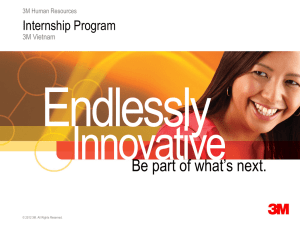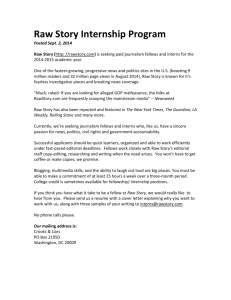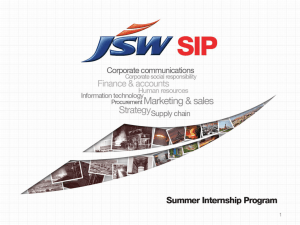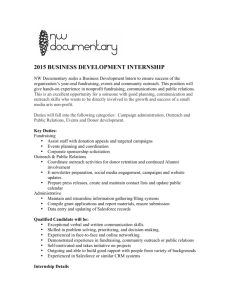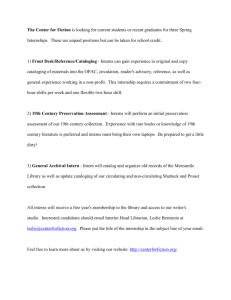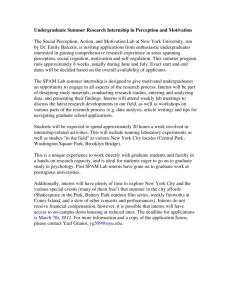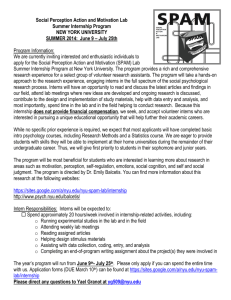Poster - Lawrence Lab
advertisement
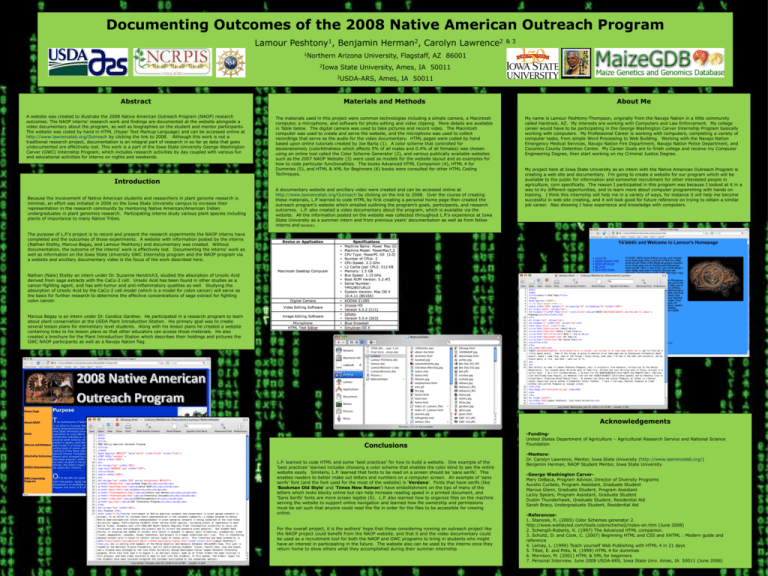
Documenting Outcomes of the 2008 Native American Outreach Program Lamour Peshtony1, Benjamin Herman2, Carolyn Lawrence2 1Northern Arizona University, Flagstaff, AZ 86001 2Iowa State University, Ames, IA 50011 3USDA-ARS, Ames, IA 50011 Abstract Materials and Methods A website was created to illustrate the 2008 Native American Outreach Program (NAOP) research outcomes. The NAOP interns’ research work and findings are documented at the website alongside a video documentary about the program, as well as biographies on the student and mentor participants. The website was coded by hand in HTML (Hyper Text Markup Language) and can be accessed online at http://www.lawrencelab.org/Outreach by clicking the link to 2008. Although this work is not a traditional research project, documentation is an integral part of research in so far as data that goes undocumented are effectively lost. This work is a part of the Iowa State University George Washington Carver (GWC) Internship Program, which includes research activities by day coupled with various fun and educational activities for interns on nights and weekends. The materials used in this project were common technologies including a simple camera, a Macintosh computer, a microphone, and software for photo editing and video clipping. More details are available in Table below. The digital camera was used to take pictures and record video. The Macintosh computer was used to create and serve the website, and the microphone was used to collect recordings that serve as the audio for the video documentary. HTML pages were coded by hand based upon online tutorials created by Joe Barta (1). A color scheme that controlled for deuteranomoly (colorblindness which affects 5% of all males and 0.4% of all females) was chosen using an online tool called the Color Scheme Generator (2), and various publically available websites such as the 2007 NAOP Website (3) were used as models for the website layout and as examples for how to code particular functionalities. The books Advanced HTML Companion (4), HTML 4 for Dummies (5), and HTML & XML for Beginners (6) books were consulted for other HTML Coding Techniques. Introduction Because the involvement of Native American students and researchers in plant genome research is minimal, an effort was initiated in 2006 on the Iowa State University campus to increase their representation in the research community by mentoring Native American/American Indian undergraduates in plant genomics research. Participating interns study various plant species including plants of importance to many Native Tribes. &3 A documentary website and ancillary video were created and can be accessed online at http://www.lawrencelab.org/Outreach by clicking on the link to 2008. Over the course of creating these materials, L.P learned to code HTML by first creating a personal home page then created the outreach program’s website which entailed outlining the program’s goals, participants, and research outcomes. L.P. also created a video documentary about the program, which is available via the website. All the information posted on the website was collected throughout L.P.’s experience at Iowa State University as a summer intern and from previous years’ documentation as well as from fellow interns and mentors. About Me My name is Lamour Peshtony-Thompson, originally from the Navajo Nation in a little community called Hardrock, AZ. My interests are working with Computers and Law Enforcement. My college career would have to be participating in the George Washington Carver Internship Program basically working with computers. My Professional Career is working with computers, completing a variety of computer tasks, from simple Word Processing to Web Building. Working with the Navajo Nation Emergency Medical Services, Navajo Nation Fire Department, Navajo Nation Police Department, and Coconino County Detention Center. My Career Goals are to finish college and receive my Computer Engineering Degree, then start working on my Criminal Justice Degree. My project here at Iowa State University as an intern with the Native American Outreach Program is creating a web site and documentary. I’m going to create a website for our program which will be available to the public for information and somewhat recruitment for other interested people in agriculture, corn specifically. The reason I participated in this program was because I looked at it in a way to try different opportunities, and to learn more about computer programming with hands on training. I think this internship will help me in a variety of ways, for instance it will help me become successful in web site creating, and it will look good for future reference on trying to obtain a similar job career. Also showing I have experience and knowledge with computers. The purpose of L.P.’s project is to record and present the research experiments the NAOP interns have completed and the outcomes of those experiments. A website with information posted by the interns (Nathan Etsitty, Marcus Begay, and Lamour Peshtony) and documentary was created. Without documentation, the outcome of the interns’ work is effectively lost. Documenting the interns’ work as well as information on the Iowa State University GWC Internship program and the NAOP program via a website and ancillary documentary video is the focus of the work described here. Nathan (Nate) Etsitty an intern under Dr. Suzanne Hendrich3, studied the absorption of Ursolic Acid derived from sage extracts with the CaCo-2 cell. Ursolic Acid has been found in other studies as a cancer-fighting agent, and has anti-tumor and anti-inflammatory qualities as well. Studying the absorption of Ursolic Acid by the CaCo-2 cell model (which is a model for colon cancer) will serve as the basis for further research to determine the effective concentrations of sage extract for fighting colon cancer. Marcus Begay is an intern under Dr. Candice Gardner. He participated in a research program to learn about plant conservation at the USDA Plant Introduction Station. His primary goal was to create several lesson plans for elementary level students. Along with his lesson plans he created a website containing links to his lesson plans so that other educators can access those materials. He also created a brochure for the Plant Introduction Station which describes their holdings and pictures the GWC NAOP participants as well as a Navajo Nation flag. Acknowledgements Conclusions L.P. learned to code HTML and some ‘best practices’ for how to build a website. One example of the ‘best practices’ learned includes choosing a color scheme that enables the color blind to see the entire website easily. Similarly, L.P. learned that fonts to be read on a screen should be ‘sans serifs’. This enables readers to better make out letters and numbers on a computer screen. An example of ‘sans serifs’ font (and the font used for the most of the website) is ‘Verdana’. Fonts that have serifs (like ‘Bookman Old Style’ and ‘Times New Roman’) have embellishment on the tips of many of the letters which looks blocky online but can help increase reading speed in a printed document, and ‘Sans Serifs’ fonts are more screen legible (6). L.P. also learned how to organize files on the machine serving the website to support online navigation and learned how file ownership and permissions must be set such that anyone could read the file in order for the files to be accessible for viewing online. For the overall project, it is the authors’ hope that those considering running an outreach project like the NAOP project could benefit from the NAOP website, and that it and the video documentary could be used as a recruitment tool for both the NAOP and GWC programs to bring in students who might have an interest in participating in the future. The website also can be used by the interns once they return home to show others what they accomplished during their summer internship. -FundingUnited States Department of Agriculture – Agricultural Research Service and National Science Foundation -MentorsDr. Carolyn Lawrence, Mentor, Iowa State University (http://www.lawrencelab.org/) Benjamin Herman, NAOP Student Mentor, Iowa State University -George Washington CarverMary DeBaca, Program Advisor, Director of Diversity Programs Aurelio Curbelo, Program Assistant, Graduate Student Marcus Glenn, Graduate Student, Program Assistant LaJoy Spears, Program Assistant, Graduate Student Dustin Thunderhawk, Graduate Student, Residential Aid Sarah Bracy, Undergraduate Student, Residential Aid -References1. Stanicek, P., (2005) Color Schemes generator 2. http://www.wellstyled.com/tools.colorscheme2/index-en.htm (June 2008) 2. Schengili-Roberts, K. (1997) The Advanced HTML companion. 3. Schultz, D. and Cook, C. (2007) Beginning HTML and CSS and XHTML : Modern guide and reference 4. Lemay, L. (1999) Teach yourself Web Publishing with HTML 4 in 21 days 5. Tittel, E. and Pitts, N. (1999) HTML 4 for dummies 6. Morrison, M. (2001) HTML & XML for beginners 7. Personal Interview. June 2008 USDA-ARS, Iowa State Univ. Ames, IA 50011 (June 2008)
